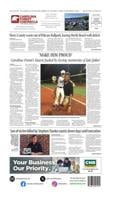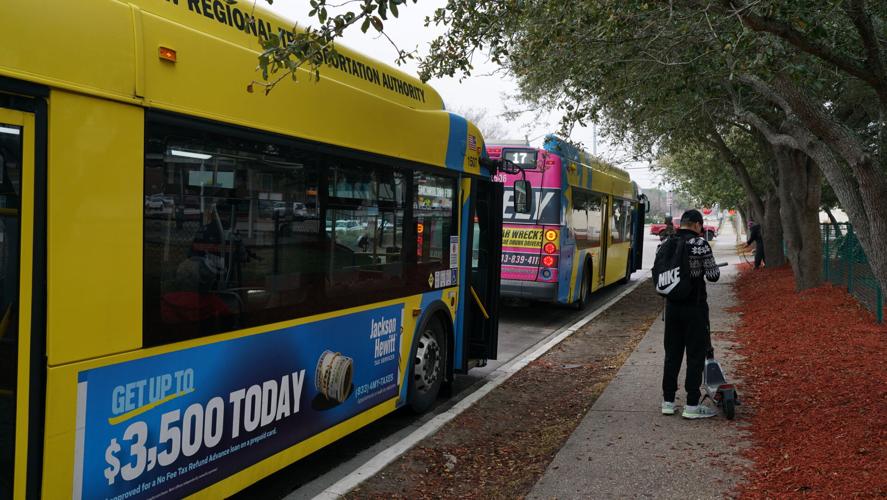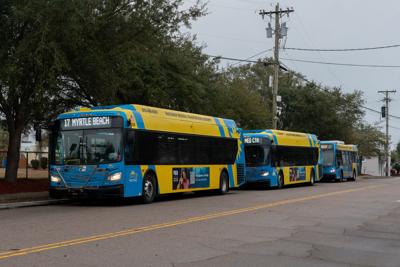Kelly Poe is a regular on the bus.
She lives a mile from her bus stop.
“I walk a mile every day, but it gets me to work on time, and it actually gets me there early. And it’s only a dollar,” said Poe, who works in Carolina Forest and lives by the Walmart in Myrtle Beach.
Poe's reason for riding the bus isn't unique.
“You can stand here [at the Myrtle Beach Transit Center] and see a fairly good cross-section of people. It’s 70% getting people to work,” said Brian Piascik, general manager and CEO of Coast RTA. “Our system is very much predicated on commuters. People have a connotation of the word commuter where they think white-collar, but these are a lot of blue-collar folks that need to get to work.”
It’s not the most convenient way to get to the job, though. The frequency of stops is minimal, meaning riders have to plan ahead, and sometimes arrive at work earlier than they would if they were driving.
Poe said she often looks for ways to kill time before the bus arrives. On some routes, the bus only comes every two hours.
“Today, it’s my day off. I had to come over here [to Carolina Forest]. The bus doesn’t run for two more hours, so I went to McDonald’s, sat there,” Poe said. “Now I have to get back on the bus to get on another bus to get over by Conway Medical Center. Then I have to get back on that bus to go to Conway. So it takes all day to do two, three appointments.”
The funding to increase routes and route frequencies just isn’t there.
Servicing Horry and Georgetown counties, Coast RTA receives about $17.2 million in annual funding, mostly from county road use fees, sales tax and federal grants. But federal grants are not guaranteed to continue as the Trump Administration makes sweeping changes across federal departments.
“The federal landscape is kind of a crapshoot right now. We have no idea how those dollars are going to flow or if they’re going to flow,” Piascik said.
A new revenue source is on its way, though.
With the passage of RIDE 4, a 25-year transportation tax to fund road improvements and transportation infrastructure in Horry County, Coast RTA is set to receive an average of $12 million a year over the next quarter century. The amount Coast RTA receives per year will increase, starting at $7.5 million.
“There is about a 2-3 year build to get a higher level of funding, which is a good strategy during road construction projects, but the bell curve trends upwards for us in terms of funding in later years,” said Lauren Morris, spokesperson for Coast RTA.
That funding is appreciated and will be a game changer for an organization that could have been eliminated a decade ago.
“This agency was about to get shut down when I came here in 2015. The county was fed up. There was all sorts of mismanagement,” Piascik said. “We’ve gotten all past that, and I think they recognize that we’re a well-run organization, and so they’ve rewarded us for that.”
That reward is 1/18th of a penny for every cent collected by the RIDE 4 transportation tax — an estimated $299 million over 25 years. That influx will balloon Coast RTA’s operating budget, allowing for replacement of aging facilities, the addition of new routes, the purchase of new buses and an increase in stop frequencies.

A bus passenger pays for a rental scooter after getting off the bus at the 10th Avenue Coast RTA transfer center in Myrtle Beach Tuesday, Feb. 11, 2025.
Of all those plans, first thing’s first.
Piascik said replacing Coast RTA’s 75-year-old maintenance facility is something that needs to happen as soon as possible.
“It’s falling down around us, so we can’t keep putting lipstick on the pig,” Piascik said. “It’s just not working.”
So much so that the organization has resorted to leasing a temporary facility for maintenance, costing more than $250,000 a year.
In addition to the 1/18th of a penny, RIDE 4 has $25 million earmarked for Coast RTA facility upgrades.
Piascik said those funds will go toward the new maintenance facility and two $5 million transit centers, one in Myrtle Beach and one in Conway. With Coast RTA’s busiest routes along the coast, moving the maintenance facility to Myrtle Beach will save mileage for its fleet. The $58 million facility will be built on Robert Grissom Parkway and will share land with a new Myrtle Beach fire station.
Piascik also wants to add buses to Coast RTA’s fleet. Some of the 23 full-size buses are already reaching their midlife point. A new diesel bus costs about $600,000, but that’s just the initial cost. Each bus on the road has a continual cost of about $400,000 per year when fuel, driver salaries, maintenance expenses and other costs are taken into account, Piascik said.
Coast RTA will also expand its workforce transportation and senior transportation options including paratransit and fixed route, which use smaller vehicles like vans and cutaways rather than large, traditional buses. Coast RTA has 13 small vehicles and 3 cutaways in its fleet.
Piascik said workforce transportation allows an employer to reach out to Coast RTA and organize a ride for its employees.
“We will subsidize that van, $700 per van, per vehicle. And the employer and those riding it cover the rest of that cost. It’s essentially a rental van. We get to take credit for the ridership and they get a more reliable way to get their employees to work,” Piascik said. “Right now we have five in operation, so we’ll continue to grow that program.”
Don’t expect new routes to pop up immediately.
RIDE 4 tax collection begins May 1, but Piascik said Coast RTA won’t see any of those funds for months later.
“We don’t see our first check until October 15th of this year. So I’m actually going to have to borrow money to make ends meet because the road use fees end on June 30,” Piascik said. “So we have cash issues that we need to fix before we start putting more service out on the street, and we need to build some buildings,” he said. “Some of it we’ll do quickly, but I don’t think there’s anything major until we get maybe three years into the plan.”
With the influx in funding and a variety of needs, Coast RTA will soon be publishing its transit development plan, a five-year plan that will break down needs based on feedback and ridership for its regular bus routes.
Ride frequency for popular routes like route 17, which connects Myrtle Beach and North Myrtle Beach will eventually see increased frequencies, Piascik said.
That’s something Poe would love to see.
“I wouldn’t have to be out here as long,” she said. “I wouldn’t have to spend an entire day to do three appointments.”









(0) comments
Welcome to the discussion.
Log In
Keep it Clean. Please avoid obscene, vulgar, lewd, racist or sexually-oriented language.
PLEASE TURN OFF YOUR CAPS LOCK.
Don't Threaten. Threats of harming another person will not be tolerated.
Be Truthful. Don't knowingly lie about anyone or anything.
Be Nice. No racism, sexism or any sort of -ism that is degrading to another person.
Be Proactive. Use the 'Report' link on each comment to let us know of abusive posts.
Share with Us. We'd love to hear eyewitness accounts, the history behind an article.